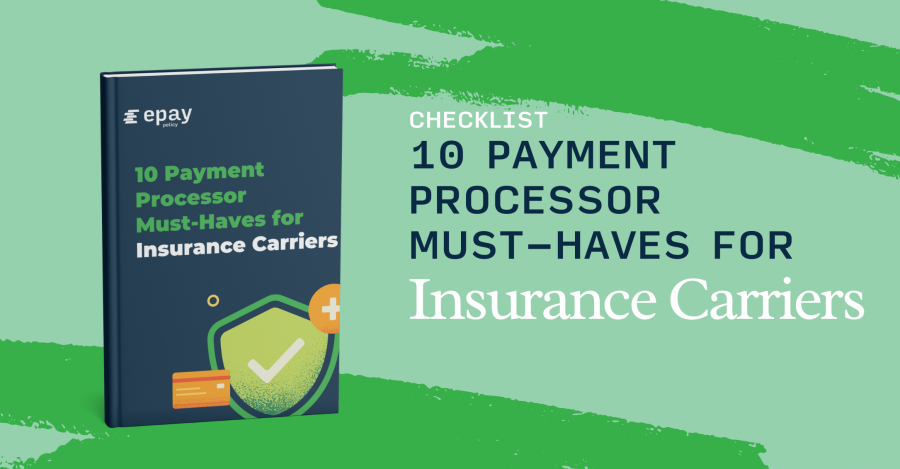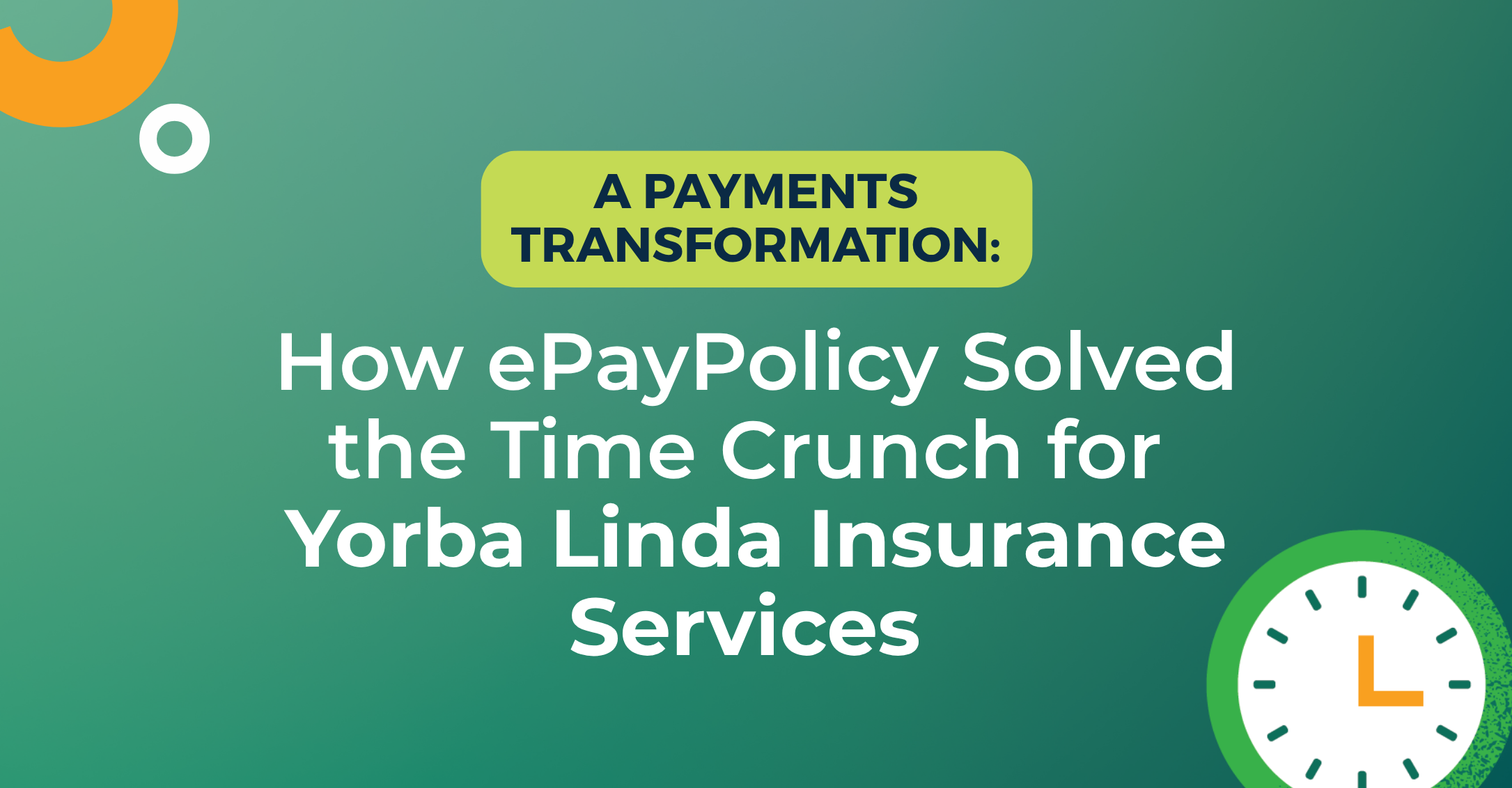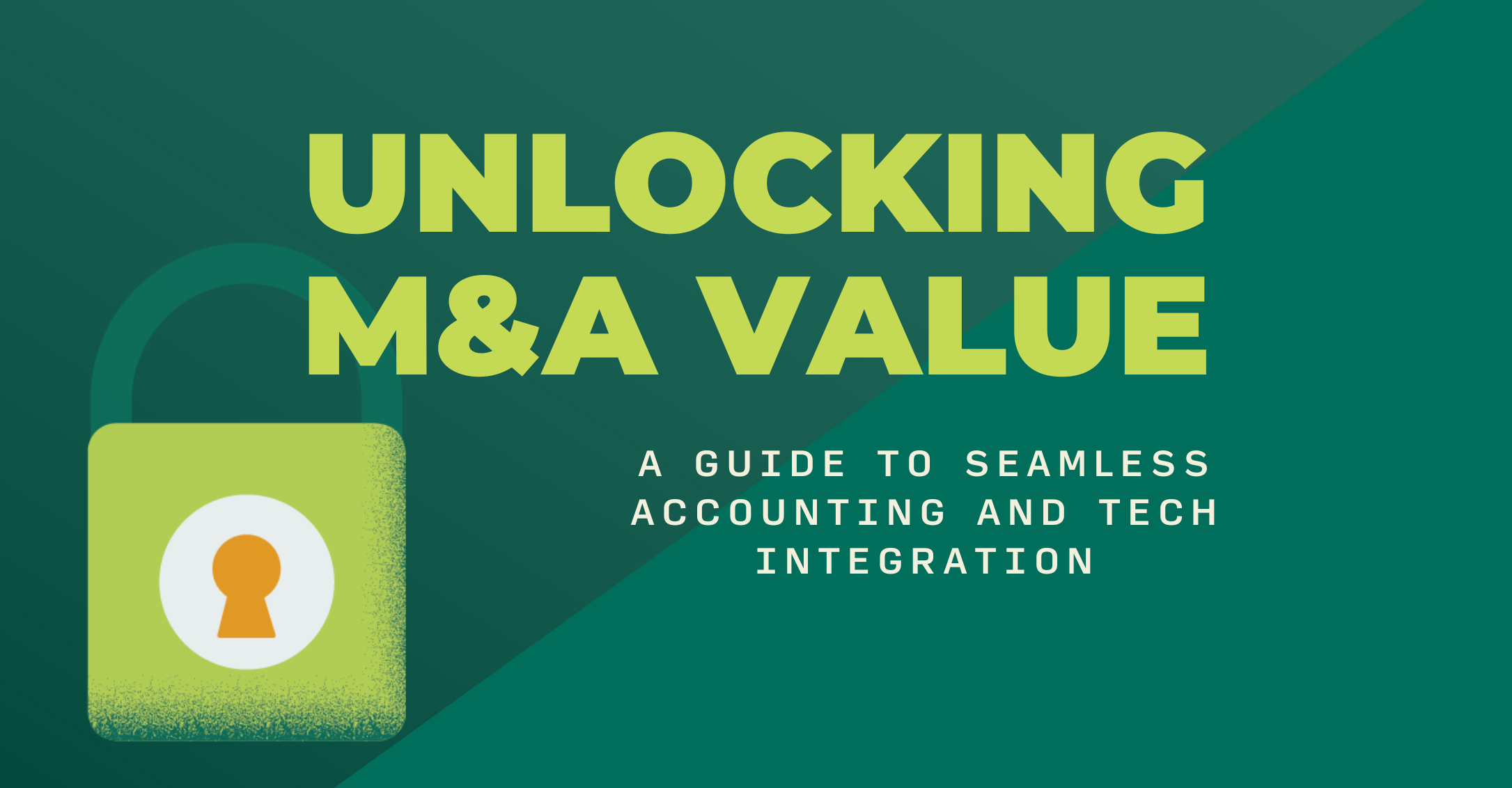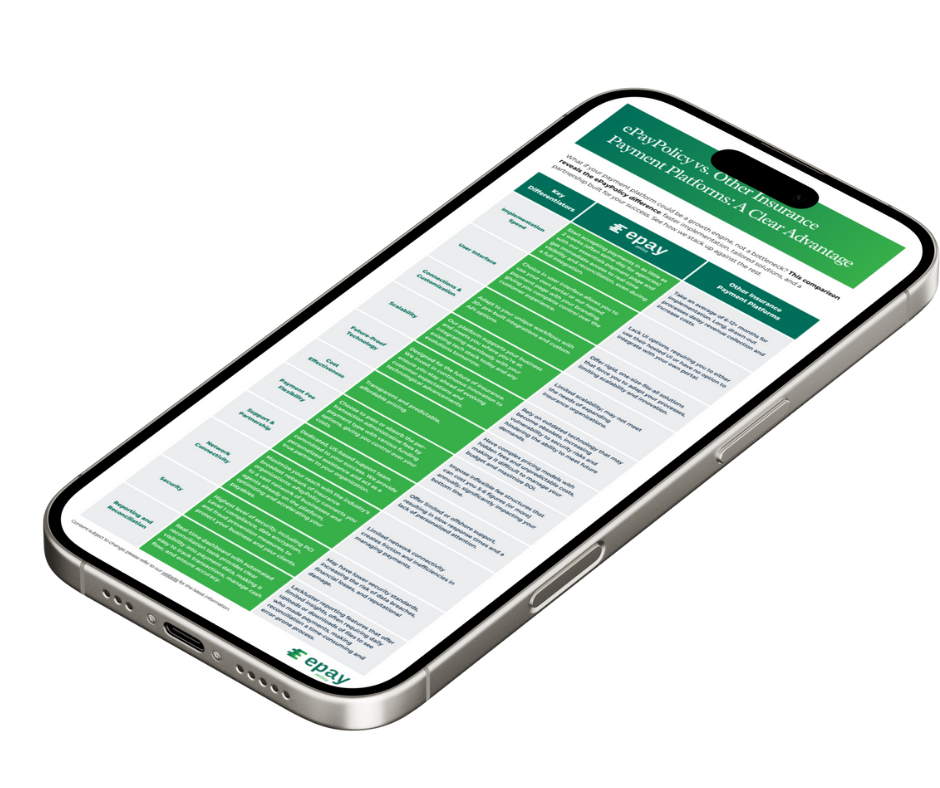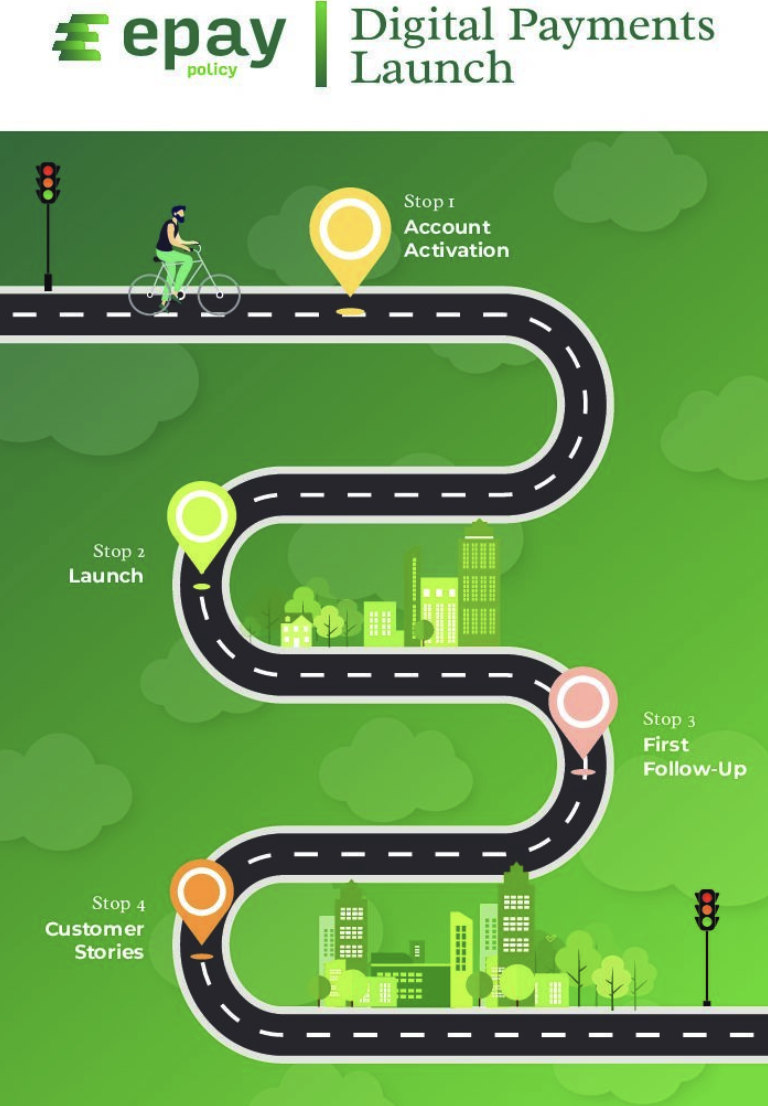FREE DOWNLOAD
Get the Checklist
When insurance carriers are choosing a payment processor, there’s a lot more to consider than just cost. Sure, price matters, but it’s just one piece of the puzzle. The process can be complex, especially when you factor in regulatory requirements, but that’s just the start.
What really matters is whether the system is easy to use for everyone involved- whether it’s agents, vendors, or policyholders. It should integrate smoothly with the software you already use, making the whole experience feel seamless. These days people expect things to be fast, simple, and secure, so payment processors need to meet modern standards of usability, speed, scalability, and data protection.
To help you navigate the decision-making process, we’ve put together a checklist that breaks down the key factors to consider when evaluating payment solutions for insurance carriers. Think of it as a roadmap to ensure you’re making the right investment for your business.
Top 10 Must-Haves for Insurance Carrier Payment Processing Solutions
Payment processing plays a crucial role in managing insurance policies. It’s not just about collecting payments—it’s an essential part of keeping everything running smoothly and ensuring that both insurers and policyholders have a seamless experience.
Carriers work with diverse stakeholders, from policyholders to agents, payers, and outside insurance companies, all of whom value an experience that is as frictionless as possible. Providing a quality payment experience is a way to differentiate from others in the industry because it sends a clear message that you value people’s time and attention.
Here are the top 10 factors to consider when choosing a payment processor solution to support your selection process.
1. Security and Compliance
Insurance companies handle high volumes of sensitive information, from personally identifiable data to financial information and transactional records. Regulatory compliance frameworks mandate that this data must be protected from unauthorized access.
Payment processors must use advanced encryption to protect data at rest and in transit. A data breach is not only a financial nightmare but can also severely damage your reputation. The cost of a breach can run into the millions, but the long-term loss of trust and credibility with clients can be just as devastating.
Industry regulations include federal, state, and local frameworks, and all must be considered. These include:
- Payment Card Industry Data Security Standard (PCI DSS) is relevant to all organizations that handle customer payments and store card information.
- HIPAA, relevant to health insurance carriers, also applies to any third parties or associates engaged or contracted to carry out health-related business on behalf of the carrier.
Ensure your chosen payment processor also adheres to local and state frameworks, as they may have additional compliance requirements. Not all states have their own laws, and with the rapid growth of AI, many are being amended or written to include additional guardrails to protect personal data and how it’s collected and used.
Lack of knowledge about such laws is no defense in case of a breach or complaint (you will still be on the hook), so looking for payment processors that provide the most stringent levels of data security, ideally at the international level, is vital. Europe’s regulation, the GDPR, sets the global standard, so if your processor complies with this framework, rest assured it will comply with all others.
2. Integration Capabilities
Your payment processor must integrate with existing systems to ensure a seamless experience for agents, claims management, policy management, and CRM platforms. With little standardization in the insurance industry, an ideal payment processor will offer broad compatibility with a range of popular systems and also be capable of connecting to custom on-premise systems through APIs.
Compare systems based on capabilities and prioritize those that you can immediately and seamlessly connect to the apps you already use. If your company uses a custom system, speak to support about how they handle APIs and what support is available to ensure they remain stable with new connections. In this case, your in-house IT team will likely need to work with their developers, so you’ll need to understand how that relationship will work. As with any business agreement, objectives must align with goals, and expectations should be established at the outset.
Lastly, always look ahead. Consider the systems you use now and what you expect to use in the future. Onboarding a new processor is not a simple task and you don’t want to repeat the process a few years later or hit a brick wall when you need to move forward. Look for growth-minded companies that encourage innovation and welcome suggestions, as they will become true partners in your success.
3. Payment Flexibility
Today’s consumer wants flexible payment choices. The companies they do business with must offer their preferred methods, otherwise they risk losing their business to a competitor that is happy to accommodate their needs. Your payment processor should align with those necessities, supporting a range of payment options, including credit cards, debit cards, digital wallets, direct bank payments, checks, and ACH transfers.
Additional features to look for in a processor include handling recurring premium payments, one-off claims, and refund payments.
Ease of use is a key consideration in all the above scenarios, as complex workflows may cause undue delays or errors. All payment methods must work seamlessly within the existing ERP, CRM, or enterprise platform to ensure data visibility and interconnectivity for relevant users, departments, and customers.
4. Customer Experience
User experience extends to both sides of the desk. You’ll want to ensure the interface is simple, intuitive, and fully integrated with company systems. Taking users off the platform to complete a transaction creates barriers in the process and may result in an inability to complete the task.
Prioritize solutions that offer easy-to-use portals for policyholders to self-manage their accounts, make payments, and receive funds.
Additionally, providing access to account history on demand, customizable notifications, and immediate confirmation of transactions is critical. Many policyholders prefer the ability to complete transactions without speaking to an agent. The above features enhance trust and support transparency and also reduce support call volume
5. Efficiency and Automation
Automation is integral to efficiency and accuracy in today’s world. Automated payment reconciliation ensures payments are applied immediately and reduces error-fraught, time-consuming manual processes, leaving agents and finance professionals more time to devote to higher-value tasks.
While people must still oversee automated processes to ensure accuracy and compliance, automation can reduce the manual workload by 90%. Recent data suggests that 80% of financial work can be successfully automated, effectively putting time back into employee’s hands.
From the customer’s standpoint, a speedy claims payment process improves satisfaction, helping to boost loyalty as they recognize their insurer cares about their wellbeing. If they have issues they need to speak to an associate about, chances are the person they reach has more time and attention to devote to the problem simply because most of their manual work is automated.
6. Scalability
Insurance companies have experienced exponential growth in claims volumes in recent years. Extreme weather and wildfires have overburdened the insurance industry, and many new insurance startups have emerged to meet the need. As people explore their options, many have shifted to new carriers, and this trend is only expected to grow. Existing companies must prepare for growth and prioritize software and vendors that can grow with them.
Cloud-based third-party services enable growth at scale as organizations are capable of adding volume quickly without overtaxing systems. Consider the solution’s capacity and any associated costs. Your payment processor may be able to offer volume discounts on processing on a sliding scale, meaning when your volume goes up your IT spend will not rise with it.
But scalability isn’t just about volume;it’s also about being able to onboard new apps and technology on demand. Technology advances rapidly, and novel trends, workflows, and functions will inevitably emerge that you’ll want to jump on immediately. With the flexibility to adapt to new markets or product lines, growth and scale will be effortless, as it should be. You’ll also be able to compete with companies at the top of your industry as you’ll offer the same convenience and excellent customer experience.
7. Cost-Effectiveness
Transaction fees add up quickly, which can present a challenge for growing carriers. During the research phase, you should understand your current costs—including the cost of delayed payments and other issues—and have a budget in mind for your new solution.
Some payment processors do not charge for using their platform, choosing instead to compensate with higher transaction fees and service fees the client must absorb.
Enterprise solutions work a bit differently as they are more feature-rich and charge a flat monthly fee for the additional service, including anything from a branded payment portal to advanced analytics, automated batch payments, paper payment processing, and seamless integration with the AMS. Transaction fees can be passed on to the policyholder or assumed by the carrier.
Compare transaction fees between platforms, but don’t base your decision solely on those numbers. When weighing additional software subscription costs, consider the payroll hours you’ll save, the reduction in collections, cash flow improvement, and the limitless value of customer satisfaction.
8. Fraud Detection and Risk Management
The threat landscape is an ever-present concern for all people and organizations. Insurance companies have elevated risk as paper checks remain prevalent in the industry. Despite the risks involved in writing and accepting checks, some people prefer to do business that way. Of course, checks are not the only risk you’ll face.
Cyber threats and data breaches are becoming more sophisticated each day. The payment processor you choose must have adequate protections in place to ensure the safety and protection of your company data and that of your customers.
Physical risk is easy to understand. However, a data breach can come from any direction, making it incredibly important to ensure your software and systems are protected by the latest security protocols. Features to look for include:
- Real-time transaction monitoring
- Anomaly detection to detect suspicious activity or suspected fraud
- Identity verification/authentication (multi-factor or token-based)
- Endpoint security to ensure integrated connections are not vulnerable
- A risk-management dashboard for system security at-a-glance
Ultimately, you don’t want to put more pressure on your IT team by onboarding software that lacks the latest features. As a fully managed SaaS, the processor oversees data security; you may or may not have options to customize it. Ideally, you want to choose a vendor specializing in the insurance industry, as they will understand your needs and concerns.
9. Reporting and Analytics
One of the most tremendous benefits of cloud systems is their ability to eliminate data silos, connect departments, and provide leadership with a high-level view of company activities. Payment processing software should be no exception.
Look for solutions that provide a robust reporting platform that delivers detailed insights into transaction trends and payment behaviors. Reports should be customizable to business objectives, draw on real-time data, be customizable for any stakeholder, and be capable of visual displays to make them easier to understand and present to others.
Advanced reporting capabilities are essential for all teams, department heads, and executive leadership. These resources uncover trends help to inform timely business decisions and can reveal customer and employee preferences, enabling optimizations that drive meaningful change.
10. Reputation and Support
Onboarding a new payment processor should be approached as a business partnership. Whether incoming or outgoing, payments are the foundation of a company’s success, and you can’t compromise on quality and reliability.
While researching, look for providers with an established track record in insurance or a similar industry, like financial services, banks, brokers, trading, and other investment services.
Once you establish a short list, look at the companies they serve and, if possible, read reviews and testimonials or speak to someone there to find out what they think.
Don’t rely on one or two opinions when reading reviews, as they may not tell the whole story. Even if the company has negative reviews (almost all will have a few), how they respond will be enlightening. Do they show concern? Have they taken action to ensure the issue doesn’t happen again? Was the situation resolved? Look for patterns and how they engage with customers. You want to know the partners you take on will care about your success.
Reliable customer support is also critical, as issues need to be resolved promptly. Money tied up in transit—incoming premium payments or claim payments going to the policyholder—is frustrating and disruptive to all involved.
Claimants want confidence that the system works as expected. If it doesn’t, the insurance company will likely endure high volumes of support requests and complaints. Carriers want to get on with business as usual and have peace of mind that systems are working as they should. Anything less could affect continuity, impede customer trust, and significantly reduce brand reputation, and this is directly and intrinsically related to support.
Final Thoughts
Carriers have an abundance of solutions when choosing a payment processor. The best payment processor for you will be a specialist in the insurance or an adjacent industry that provides the integrations, pricing, features, capabilities, flexibility, and support you and your policyholders need. We hope you’ll use this checklist to inform your payment processor search journey.
Are you interested in deeper insights on payment processors or solutions explicitly tailored for insurance carriers? Schedule your ePayPolicy live demo today; we’d love to show you how we help.
- Steve Millerhttps://epaypolicy.com/blog/author/steve-miller/
- Steve Millerhttps://epaypolicy.com/blog/author/steve-miller/
- Steve Millerhttps://epaypolicy.com/blog/author/steve-miller/
- Steve Millerhttps://epaypolicy.com/blog/author/steve-miller/

